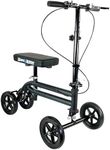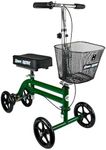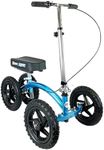Buying Guide for the Best Knee Scooter
Choosing a knee scooter can make a big difference in your comfort and mobility while recovering from a foot or ankle injury. The right knee scooter should support your weight, fit your body size, and be easy to maneuver in the spaces you use most. Think about where you'll use it—indoors, outdoors, or both—and how often you'll need to transport or store it. Your daily routine, physical needs, and environment should guide your decision.Weight CapacityWeight capacity refers to the maximum amount of weight the knee scooter can safely support. This is important because using a scooter that can't handle your weight can be unsafe and may damage the scooter. Weight capacities are usually divided into standard (up to about 300 pounds), heavy-duty (300-400 pounds), and bariatric (over 400 pounds). To pick the right one, check your current weight and choose a scooter that supports at least that much, ideally with a little extra margin for safety.
AdjustabilityAdjustability means how much you can change the height of the knee platform and handlebars. This is important for comfort and proper posture, which helps prevent strain on your back and arms. Most scooters offer a range of adjustments to fit different heights. If you are shorter or taller than average, look for a scooter with a wide range of adjustments. Make sure you can set the knee pad so your injured leg is bent at a comfortable angle and the handlebars are at a height that lets you steer easily.
Wheel Size and TypeWheel size and type affect how smoothly the scooter rolls and what surfaces it can handle. Smaller wheels (about 6-8 inches) are best for smooth indoor floors, while larger wheels (8-12 inches or more) can handle bumps, cracks, and outdoor surfaces better. Some wheels are solid, which means they won't go flat, while others are air-filled for a softer ride. If you'll mostly use the scooter indoors, smaller solid wheels are fine. For outdoor use or rougher surfaces, look for larger, air-filled wheels.
Turning RadiusTurning radius is how tightly the scooter can turn. A smaller turning radius means the scooter can make sharper turns, which is helpful in tight spaces like hallways or bathrooms. Scooters with a larger turning radius are less maneuverable but may feel more stable. If you need to use the scooter in small rooms or crowded areas, look for one with a small turning radius. For open spaces, this is less important.
Portability and FoldingPortability and folding refer to how easy it is to collapse the scooter for transport or storage. This is important if you need to take the scooter in a car or store it in a small space. Some scooters fold down quickly and easily, while others are bulkier. If you travel often or have limited storage, choose a model that folds compactly and is light enough for you or a helper to lift.
Braking SystemThe braking system is how you stop or slow down the scooter. Most knee scooters have hand brakes, similar to a bicycle, and some have dual brakes for extra safety. A good braking system is important for control, especially on slopes or uneven ground. If you plan to use the scooter outdoors or on ramps, make sure the brakes are easy to use and reliable. Test the brakes to ensure you can operate them comfortably with your hand strength.
Knee Pad ComfortKnee pad comfort refers to the cushioning and shape of the platform where your injured leg rests. This is important because you'll spend a lot of time with your knee on the pad, and poor cushioning can cause pain or pressure sores. Pads come in different shapes and thicknesses. If you have sensitive skin or will use the scooter for long periods, look for a thick, contoured pad with soft covering. Try it out if possible to make sure it feels comfortable for your leg size and shape.
















